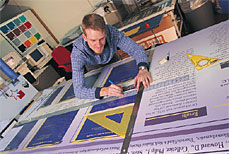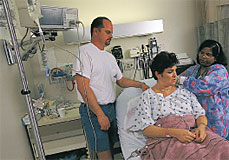|


| Working late into the
evening, graphic artist Ian Reynolds puts the final touches
on a scientific poster session to be displayed at a national
conference. |
|
 f
one word were to best describe the professionals in M. D. Anderson’s
Medical Graphics and Photography, it would have to be “creative.” f
one word were to best describe the professionals in M. D. Anderson’s
Medical Graphics and Photography, it would have to be “creative.”
 Every
day, they are designing printed materials, assisting with institutional
web sites, making slides for presentations, drawing medical and
scientific illustrations, and taking photographs for faculty and
staff. Every
day, they are designing printed materials, assisting with institutional
web sites, making slides for presentations, drawing medical and
scientific illustrations, and taking photographs for faculty and
staff.
 Last
year alone, the department’s Computer Graphics Imaging Services
unit produced 58,236 slides, while the Medical Illustration and
Graphic Design group completed 1,325 projects. More than 7,800 work
requests for prints, slides and film processing were filled by Medical
Photography and Photography Laboratory Services, resulting in 102,887
units produced. Last
year alone, the department’s Computer Graphics Imaging Services
unit produced 58,236 slides, while the Medical Illustration and
Graphic Design group completed 1,325 projects. More than 7,800 work
requests for prints, slides and film processing were filled by Medical
Photography and Photography Laboratory Services, resulting in 102,887
units produced.
 The
team of 23 full-time employees is a valuable resource to M. D. Anderson,
says Mary Dorta, director of medical graphics and photography. “We
pride ourselves as being experts in the fields of medical and scientific
art and photography, and being able to meet the diverse needs of
our clients.” The
team of 23 full-time employees is a valuable resource to M. D. Anderson,
says Mary Dorta, director of medical graphics and photography. “We
pride ourselves as being experts in the fields of medical and scientific
art and photography, and being able to meet the diverse needs of
our clients.”
|

 D. Anderson operates the busiest hospital-based pharmacy in the world.
D. Anderson operates the busiest hospital-based pharmacy in the world.
 Last
year, 139 pharmacists and 145 support personnel accounted for 4,769,226
drug doses administered to inpatients, 603,000 medication doses
given in the Ambulatory Treatment Center and 177,500 prescriptions
filled for outpatients. Last
year, 139 pharmacists and 145 support personnel accounted for 4,769,226
drug doses administered to inpatients, 603,000 medication doses
given in the Ambulatory Treatment Center and 177,500 prescriptions
filled for outpatients.
 Pharmacists
have had pivotal roles in helping clinicians evaluate investigational
chemotherapy agents, develop an array of portable drug infusion
pumps, and counsel patients and families. Pharmacists
have had pivotal roles in helping clinicians evaluate investigational
chemotherapy agents, develop an array of portable drug infusion
pumps, and counsel patients and families.
 “Over
the years, we have found that it is extremely important to have
pharmacists and pharmacy locations as close as possible to patients
when they require drug therapy. This is especially true for patients
in the critical care units,” says Roger W. Anderson, head of
the Division of Pharmacy. “Over
the years, we have found that it is extremely important to have
pharmacists and pharmacy locations as close as possible to patients
when they require drug therapy. This is especially true for patients
in the critical care units,” says Roger W. Anderson, head of
the Division of Pharmacy.
 New
dedicated satellite pharmacies for the intensive care unit (ICU),
the operating rooms, and pediatric and hematology inpatients were
opened earlier this year in the Albert B. and Margaret M. Alkek
Hospital. Four other satellite units are available in strategic
locations. New
dedicated satellite pharmacies for the intensive care unit (ICU),
the operating rooms, and pediatric and hematology inpatients were
opened earlier this year in the Albert B. and Margaret M. Alkek
Hospital. Four other satellite units are available in strategic
locations.
|

|
Pharmacy technologist
Jeri Prados (forefront) checks a chemotherapy solution,
while pharmacy supervisor Margaret Reilly readies a patient’s
prescription in the new ICU satellite pharmacy. It is open
16 hours a day.
|
|

|
|
Larry
Lindsey comforts his wife, Linda, a leukemia patient from Memphis,
Tennessee, while nurse Mary Joseph monitors her condition during a
recent visit to the Emergency Center. Open around the clock, the 23-bed
Emergency Center is part of M. D. Anderson’s pioneering Ambulatory
Treatment Center. |
|





